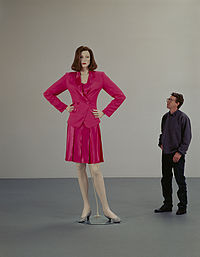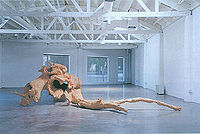- Charles Ray (artist)
-
Charles Ray (born 1953) is a Los Angeles-based sculptor. He is known for his strange and enigmatic sculptures that draw the viewer’s perceptual judgments into question in jarring and unexpected ways. Christopher Knight in the Los Angeles Times wrote that Ray’s “career as an artist…is easily among the most important of the last twenty years.”[1]
Contents
Early life and education
Charles Ray was born in Chicago as the son of Helen and Wade Ray. He has four brothers and a sister. He earned his BFA at the University of Iowa and his MFA from Mason Gross School of the Arts at Rutgers University.
He studied sculpture at the University of Iowa School of Art and Art History with Roland Brener, who exposed Ray to many of developments of Modernist sculpture, in particular the constructivist aesthetic of artists like Anthony Caro and David Smith. In an interview, Ray spoke of his artistic education and early influences.
"Caro’s work was like a template; I saw it as almost platonic. The formal rules as taught by Brener were a kind of nourishment for me. The actual working in the studio was, in a sense, the expression. I was taught that the finished sculpture was maybe the end of the paragraph. Once a sculpture was completed it was critiqued and put back on to the scrap pile. This way of working taught me to think sculpturally rather than to think about sculpture. At this time in my life the historical context of high Modernism was really beyond my grasp. I saw Caro as super-contemporary. His work was, and is, so alive. It bridges the gap between the inside and outside of my mind. [2]"
Ray has headed the sculpture department at UCLA since 1981.[3]
Work
Ray’s work is difficult to classify. Style, materials, subject, presence, and scale are all variable. What is consistent is as critic Anne Wagner put it, “In all his seamlessly executed objects, Ray fixates on how and why things happen, to say nothing of wondering what really does happen in the field of vision, and how such events might be remade as art.”[4] This and the level of art historical awareness behind his works has led many critics to call Ray a sculptor’s sculptor. Nevertheless, his art has managed to find a large audience, thanks in part to its often striking or beguiling nature.
Ray recapitulated many of the developments in twentieth-century sculpture in his first show in 1971 with an installation entitled One-Stop Gallery. The show consisted of a collection of small sculptures, resting directly on floor. Some of the works, in their attention to materials, were clearly inspired by Minimalist artists like Robert Morris, while two small constructed steel sculptures invoke the traditions taught by his teacher, Brener; they were even painted the same red as Caro’s Early One Morning (1962, Tate Modern). One-Stop Gallery would anticipate the tone for much of Ray’s work to come in its plumbing and reinterpreting of the canon of twentieth-century sculpture without having his own work appeal to any particular period or style. Initially influenced by Caro, by including his own body in his works he made them more like documented performances. In the two-part photographic work Plank Piece I–II (1973), for example, he pinned his body to the wall with a large piece of wood.[5]
In the late 1980s, Ray conceived Minimalist works using ink and wire. In Ink Box (1986), a large cube is filled to the brim with ink, giving the illusion of a solid cube. Ink Line (1987) is a continuous stream of black ink traveling from a dime-size opening in the ceiling into a similar hole in the floor. In Spinning Spot (1987), a section of the floor measuring 24 inches in diameter is set spinning at 33 RPM. Consisting of a single 8.5 foot length of wire, both ends of Moving Wire (1988) protrude from the wall and are set 14 inches apart; as one end of the wire extends out from the wall at random intervals, the other retracts.[6]
For Unpainted Sculpture (1997), over the course of two years, Ray has reconstructed a life-sized crashed Pontiac Grand Am (circa 1991) out of fiberglass, casting and assembling each piece to match the bent and twisted forms of the original [7] Despite the work’s misleading title, it is painted a soft dove grey that is reminiscent of the plastic parts of model car kits.[8]
His most work-intensive to date is the ten-year re-creation in Japanese cypress (Hinoki) of a fallen and rotting tree he had found in a meadow. With Hinoki (2007, Art Institute of Chicago), Ray had a mold made of a large rotting tree he found in California. He then hired a team of Japanese woodcarvers in Osaka to essentially re-carve the tree in Hinoki, a different wood than that of the original tree. In a forthcoming interview, Ray made it clear that the purpose of the piece was not to photorealistically carve an exact replica of the tree. “The tree had that beautiful interior that fallen logs have,” he says. “It happens when bugs eat out the hard wood, so you have this hollow thing. All I knew was that I wanted to carve that, I wanted them to have a sense of that interior [of the log] because it’s in there, even if normally it couldn’t be seen. So that was really important. And then I became involved with the outside as well…It mattered to me that somebody had looked at it, and I wanted to make it matter to you.”[9] Hinoki took four years to carve of what was a ten year project: from the initial discovery of the tree in 1997-1998 to its exhibition in 2007.
Ray's critically acclaimed Firetruck (1993), a full-size aluminum, fiberglass and Plexiglas installation, has been exhibited on Madison Avenue in New York, in front of the Whitney Museum of American Art. The giant replica of a red toy firetruck was also exhibited outside the Los Angeles County Museum of Art in 2008.[10]
In 2009, Ray installed Boy with Frog, his first outdoor commissioned work, at the Punta della Dogana, Venice. Grand in size and realized with a smooth white finish that references the important tradition of marble sculpture in Italy, it depicts a boy holding a goliath frog above the Grand Canal. The sculpture calls to mind the Apollo Sauroktonos, an ancient Roman sculpture at the Musée du Louvre in Paris of a nude adolescent reaching out his arm to catch a lizard climbing a tree; and, the Boy with Thorn|Spinario, a bronze statue at the Palazzo dei Conservatori, Musei Capitolini, of a seated Roman boy plucking a thorn from the sole of his foot.[11]
Exhibitions
Charles Ray had his first one-person museum exhibition in 1989. His art has since been featured in numerous solo and group exhibitions in Europe and North America, including a traveling, mid-career retrospective organized by Paul Schimmel for the Museum of Contemporary Art, Los Angeles, which then traveled to the Museum of Contemporary Art, Chicago and the Whitney Museum of American Art. Other solo exhibition venues include the Institute of Contemporary Art, London; Kunsthalle Bern, Switzerland; and Astrup Fearnley Museet for Moderne Kunst, Oslo, Norway.[12] He has exhibited at documenta IX (1992), Venice Biennales in 1993 and 2003, and four Whitney Biennials.
Major works
- Ink Box, 1986, Orange County Museum of Art
- How a Table Works, 1986, Museum of Contemporary Art, Los Angeles
- Fall ’91, 1992, Museum of Contemporary Art, Los Angeles
- Oh! Charley, Charley, Charley..., 1992, Private Collection
- Family Romance, 1993, Museum of Modern Art, New York
- Unpainted Sculpture, 1997, Walker Art Center, Minneapolis
- Hinoki, 2007, Art Institute of Chicago
- Boy with Frog, 2009, Punta della Dogana, Venice, Italy
Selected bibliography
Books on Charles Ray
- Ray, Charles. Charles Ray. Los Angeles: Museum of Contemporary Art, 1998.
- Ray, Charles. Charles Ray. Malmö: Rooseum – Center for Contemporary Art, 1994.
Articles on Charles Ray
- “Art in Review.” New York Times, November 30, 2007, sec. E
- Hainley, Bruce. “Charles Ray at Regen Projects.” Artforum, January 1998, 91.
- Knight, Christopher. “Charles Ray’s Hinoki: A Wooden Record of Life.” Los Angeles Times, May 11, 2007.
- Relyea, Lane. “Charles Ray: In the No.” Artforum, September 1992, 62-66.
- Rutledge, Virginia. “Ray’s Reality Hybrids.” Art in America, November 1998, 96-100, 142-143.
- Wagner, Anne. “Review of ‘Charles Ray’ at the Museum of Contemporary Art, Los Angeles.” Artforum, May 1999, 171-172.
Interviews with Charles Ray
- Bonami, Francesco. “Charles Ray: A Telephone Conversation.” Flash Art, Summer 1992, 98-100.
- Fried, Michael. “Early one Morning…” Tate Etc., Spring 2005, 50-53.
- Storr, Robert. “Anxious Spaces.” Art in America, November 1998, 101-105, 143-144.
Writings by Charles Ray
- Ray, Charles. “Thinking of Sculpture as Shaped by Space.” New York Times, October 7, 2001, 34.
- __________. A Four Dimensional Being Writes Poetry on a Field with Sculptures. New York: Matthew Marks Gallery, 2006.
- __________. “1000 Words: Charles Ray Talks about Hinoki, 2007.” Artforum, September 2007, 4.
References
- ^ Christopher Knight, “Charles Ray’s Hinoki: A Wooden Record of Life,” Los Angeles Times, May 11, 2007.
- ^ Charles Ray and Michael Fried, “Early one Morning…,” Tate Etc., Spring 2005, 5
- ^ Charles Ray / MATRIX 140, November 1, 1990 - December 20, 1990 Berkeley Art Museum and Pacific Film Archive, Berkeley.
- ^ Anne Wagner, “Charles Ray: Museum of Contemporary Art, Los Angeles,” Artforum, May 1999, 171.
- ^ Charles Ray Tate Collection, London.
- ^ Charles Ray: Ink Line, Moving Wire, Spinning Spot, May 8 - July 10, 2009 Matthew Marks Gallery, New York.
- ^ CHARLES RAY: "UNPAINTED SCULPTURE," 1997, October 18 - November 29, 1997 Regen Projects, Los Angeles.
- ^ Michael Darling, Charles Ray Frieze, Issue 39, March-April 1998.
- ^ Michael Fried, and Charles Ray, “Conversation” forthcoming in Charles Ray by the Matthew Marks Gallery
- ^ Suzanne Muchnic (April 12, 2008), Public art a victim of its success Los Angeles Times.
- ^ J. Paul Getty Museum To Put Sculpture By Celebrated Los Angeles Artist Charles Ray On View - Model for Artist's "Boy with Frog" makes U.S. debut at the Getty Center Press Release of July 25, 2011.
- ^ Charles Ray - Professor, Sculpture UCLA Department of Art.
External links
Categories:- American sculptors
- University of Iowa alumni
- 1953 births
- Living people
Wikimedia Foundation. 2010.




